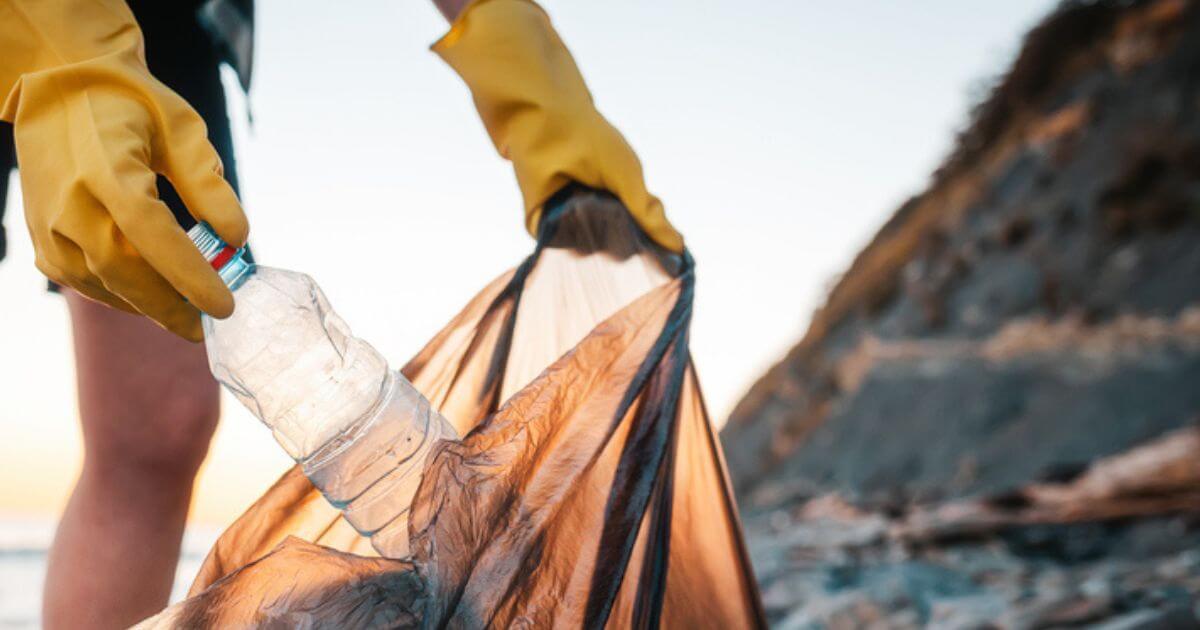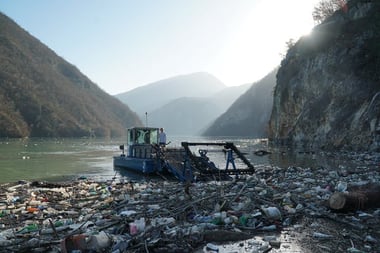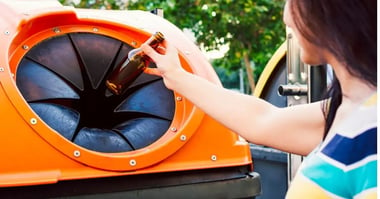
Beth Howell
Beth has been writing about the environment and climate change for over four years now – with her work being featured in publications such as The BBC, Forbes, The Express, Greenpeace, and in multiple academic journals.
It's estimated that about 11 million tonnes of plastic enter the oceans each year, according to Ocean Conservancy, which takes a massive toll on marine life and contributes to climate change.
So, what’s the best way to clean up the oceans and avoid this harm?
There are a number of ways we can do this, but the most effective one is to remove waste at the source — from land and rivers. This way, we can prevent plastic (and other forms of waste) from reaching the sea and traveling across the world through the currents.
If you want to learn about the other ways we can prevent plastic pollution from building up in our oceans, read on to find out the six most effective methods, as well as the benefits of cleaning up marine plastic pollution.
Want to help stop ocean pollution? Us too. At CleanHub, we help brands reduce their plastic footprint while supporting coastal communities around the world. If you want to get involved, all you have to do is get in touch with our team of in-house experts.
What’s on this page?
01 | Summary: What are the 6 best ways to clean up the ocean?02 | How can we clean up the ocean?
03 | Why do we need to clean up the oceans?
04 | What cleans oceans naturally?
05 | Summary
Summary: What are the 6 best ways to clean up the ocean?
1. Stop plastic pollution at the source
2. Carry out beach cleanups
3. Avoid agricultural runoff entering the oceans
4. Create business incentives to eliminate plastic use
5. Develop and improve waste management laws
6. Invest in plastic pollution innovations
How can we clean up the ocean?
There is no silver bullet when it comes to removing plastic from the oceans — we need to target this mission from multiple angles. We've created a list below to give you a better idea of the different ways we can clean up the ocean.
1. Stop plastic pollution at the source
The key way to rid our oceans of plastic is to prevent waste from actually getting there in the first place. Like most things in life, it’s best to address the underlying cause (plastic disposal), rather than the symptom (marine plastic pollution).
This means, to eradicate ocean plastic pollution, we need to stop waste from entering rivers and coastlines — where roughly 80% of the plastic waste entering the oceans comes from.
How do we do that? It starts with making sure everyone around the world has access to an effective waste management system.
Many regions around the world lack the resources and finances to recycle plastic, meaning locals are left with two main options: burn their waste or discard it in the nearby environment. Not only is this bad for local ecosystems, but it's terrible for human health too.
In fact, burning plastic and treated wood can release heavy metals and toxic chemicals, such as dioxin, benzo(a)pyrene (BAP), and polyaromatic hydrocarbons (PAHs), which have been shown to cause cancer.
At CleanHub, it’s our mission to make this an issue of the past. We collect plastic waste directly from households, businesses, and the environment in coastal regions to stop it from entering the oceans. You can find out more about this on our page: How Do We Collect Plastic Waste?
Thankfully, countries around the world are also focusing their efforts on stopping waste before it can enter the oceans.
For example, in Kenya, Chemolex Company and Smart Villages are placing fences near the Athi River to divert the waste to conveyor belts. The Ocean Conservancy is also trying to make the Song Hong River in Vietnam plastic-free by using locally designed cleanup tools, made with two booms and a mesh.
2. Carry out beach cleanups
Of course, it’s important to continue cleaning up the planet whilst also cutting off plastic pollution from the source — and beach cleanups are one of the easiest ways to do this.
For starters, litter-picking on beaches is much easier than cleaning the ocean; you don’t need any fancy technology or a substantial investment. All you have to do is round up a few volunteers from the local community to pick up litter every few days.
Just how effective is this method? Well, each organization doing a beach cleanup can make a huge dent in the amount of plastic prevented from going into the ocean. For example, the Ocean Conservancy's International Coastal Cleanup has collected more than 325 million kilograms of trash from beaches and waterways worldwide since its inception.
And if you don't live near a beach, get involved by cleaning up your local riverbed — it has the same impact as a beach cleanup.
3. Avoid agricultural runoff entering the oceans
Agricultural runoff can lead to excess nutrients in waterways, which then go on to pollute the ocean. Often containing strong fertilizers, this runoff then creates a “dead zone”, meaning wildlife struggle to survive there. There are currently 415 dead zones around the world.
So how can we stop agricultural runoff from entering the oceans? The best way is by eliminating the problem at its root, creating awareness amongst farmers, and supporting them in reducing nutrient runoff.
Here are a few things farmers can do to reduce agricultural runoff from entering nearby waterways:
- Avoid hosting livestock near bodies of water
- Use grass, native buffers, trees, or shrubs as a barrier between tilled lands and water bodies
- Fill any tilled fields with stubble (often including straw and chaff) during winter
- Don’t leave manure piles open. Instead, place grass or another native buffer barrier between them and the water bodies
- Only use manure and other fertilizer sources when the crops can fully utilize them
4. Create business incentives to eliminate plastic use
We all have a part to play in the protection of the ocean — especially businesses and governments.
Providing financial incentives to companies can significantly reduce plastic waste, increase recycling rates, and encourage a more circular economy. The first steps to achieving this include:
- Investors taking more interest in companies that are making efforts to reduce their plastic usage
- Companies offering incentives to customers that are willing to switch from plastic to other materials, or return the packaging for recycling
- Governments offering tax cuts for companies opting for plastic-free business practices, and implementing more stringent extended producer responsibility (EPR) laws
Thankfully, governments and brands are already rolling out incentives for this important cause. The deposit refund scheme (DRS) is a good example of this. It involves refunding a small initially charged tax back to the consumer when they return packaging for recycling.
One of these schemes in South Australia resulted in a three-fold decrease in the beverage containers trashed on the beach.
DRS systems also operate throughout Europe, with the main countries including Croatia, Denmark, Estonia, Finland, Germany, the Netherlands, Norway, Sweden, Iceland, and Lithuania.
5. Develop and improve waste management laws
If we want to keep our oceans clean, we need to make sure every country has an effective waste management system in place. More importantly, we need to have laws that keep these systems in check.
Unfortunately, that’s not the case today — but there are signs of improvement in various regions around the world.
Some governments are introducing more stringent laws and standards that hold companies accountable for their plastic usage.
For example, many cities in the US, including New York and Chicago, have either banned plastic bags or taxed them. Similarly, the European Union (EU) recently took steps to eliminate new plastic usage by banning single-use plastic plates, cutlery, straws, balloon sticks, and cotton buds.
Without these new laws, it's been reported that the EU would see a further 19% increase in packaging waste by 2030.
Many countries are also enforcing Extended Producer Responsibility (EPR). This strategy holds plastic producers accountable for their waste throughout the whole life cycle of the product — from the moment it’s created to the way it’s disposed of.
EPR laws have existed in many European countries for decades now, but it’s promising to see countries in other continents embracing this law. For example, the Philippines recently announced its EPR of 2022 law, making it mandatory for any business operating in the Philippines to reduce single-use plastic waste and engage in a plastic credits program.
6. Invest in plastic pollution innovations
Humans are clever creatures. Over the past few decades, we've seen rapid development of incredible tech creations — and the environmental field is no exception to this tech frenzy.
Experts in the industry are coming up with new ways to recover plastic waste in the oceans, reduce the chance of plastic getting to the sea, and also evolve recycling facilities and capabilities.
For example, the Inner Harbor Water Wheel — located at the Jones Falls River in America — catches trash trying to enter Baltimore’s Inner Harbor. Creator John Kellet sparked this idea when he walked past Pier 6 on his way to work, and witnessed the buildup of trash.
And at CleanHub, we use tech to collect waste effectively and avoid greenwashing. We use a real-time feed of the data coming into our system from our collection hubs to monitor the amount of plastic collected. Learn more about our processes on our Impact Tracking page.
The Ocean Cleanup is another incredible example of how we can utilize tech to recover plastic from the ocean. This non-profit organization has created a machine that is able to collect plastic waste on the surface of the water, whilst also limiting any bycatch issues. So far, Ocean Cleanup has recovered over 7,000,000 kg of plastic waste from the ocean.
However, some experts in the environmental space warn that we need to tread carefully with this method of collection, claiming that the Ocean Cleanup’s efforts are "inefficient and often produce pollution themselves". They also suggest that this approach can kill sea creatures — the very animals these efforts are ultimately trying to protect.
What cleans oceans naturally?
In 2016, Japanese scientists discovered Ideonella Sakaiensis — a bacterium capable of cleaning the ocean naturally, because it consumes polyethylene terephthalate (PET).
The Ideonella Sakaiensis uses two digestive enzymes, termed hydrolyzing PET or PETase, to break down long PET molecular chains into smaller ones.
They are further broken down into smaller chunks and used as carbon and energy sources by the Ideonella Sakaiensis for growth.
After the ground-breaking discovery, scientists have started researching genetic modification to improve its efficiency. Many studies are also being carried out to modify other bacteria that have high enzyme production capability, such as e-coli, to produce PETase and break down the plastic at a higher rate.

Why do we need to clean up the oceans?
As ocean-bound plastic continues to accumulate around the world, animals, ecosystems, and humans are all suffering. Here are the key reasons why we need to stop this build-up of plastic from continuing.
Plastic takes hundreds of years to degrade
Plastic takes decades — sometimes even centuries — to break down and degrade. Items can take anywhere between 20 and 500 years to decompose, depending on the type of plastic.
One study found that plastic items lost less than 1% of weight per year for polyethylene, polystyrene, and polypropylene items. This increased slightly to 3–5% for latex, and between 7–27% for polyester and polylactic-acid compostable bags.
The most concerning issue is that most of the discarded plastic items aren’t used for long — an average plastic bag is only used for 12 minutes.
To tackle this constant dumping of plastic, coupled with the slow rate of degradation, we need to reduce our plastic production and look for alternative materials that can decompose more easily.
Trash turns into microplastics
When plastic items eventually start to decompose, they break down into smaller particles, also known as microplastics.
Not only do these tiny pieces of plastic make it much harder to clean, but they're also much easier for animals to consume — making plastic even more harmful to wildlife.
And as more animals in the food chain continue to digest microplastics, larger animals are seeing the effects. Microplastics have now been found in humans — a recent study even found plastic fragments in the placenta.
As if that wasn't scary enough, scientists have also found microplastics in the clouds in Japan, claiming that "Microplastics may have become an essential component of clouds, contaminating nearly everything we eat and drink via ‘plastic rainfall'".
Ocean pollution kills marine life
Ocean pollution is detrimental to marine life, with more than 100,000 marine animals falling victim to plastic pollution each year.
The animals often mistake plastic for food, which can choke animals or cause serious harm to their organs. And even if marine life don't make this mistake, they can end up consuming the stuff as bycatch when hunting, or because their prey had previously eaten plastic.
On top of this, marine life and seabirds get entangled in plastic waste in the ocean, which either directly strangles them or hinders their ability to move, feed, or swim.
And to make matters even worse, untreated waste contaminates the oceans, destroying precious ecosystems and habitats. As a result, many animals are forced to migrate to areas that aren’t suitable for them.
Plastic pollution is linked to climate change
Each stage of a piece of plastic's lifecycle (including extraction, refining, and manufacturing) is carbon intensive because it relies on fossil fuels.
As a result, plastics emit 3.4% of global greenhouse gas emissions, according to the OECD.
In 2019, plastics generated 1.8 billion tonnes of greenhouse gas (GHG) emissions, which is set to more than double by 2060, reaching 4.3 billion tonnes of GHG emissions.
Some scientists have also found that these plastics invading the environment can have an even worse impact on the planet. For example, airborne microplastics found in remote regions, such as the Arctic, contribute to accelerated warming by absorbing light and decreasing the surface albedo (the fraction of the sunlight reflected by the surface of the Earth) of snow.
Summary
There you have it — the best ways we can clean up the oceans. Although we should be utilizing all of these methods, our key focus should be to stop plastic pollution at the root cause, otherwise we'll never break the cycle.
We believe that the most efficient and financially sustainable way to solve plastic pollution is to build up a global network of waste collection infrastructures in high-impact locations. And that's exactly what we're doing at CleanHub.
Brands that want to take immediate action can partner with us to help stop plastic from entering the Oceans. This is the first step towards our goal: A world free from plastic pollution.
At CleanHub, we’re committed to helping brands improve their environmental impact and work toward a more circular economy. Want to get involved? Get in touch with our experts today to learn about how you can reduce your business’s plastic footprint.

.webp)
.png?width=380&name=CleanHub%20Bcorp%20(1).png)

.webp?width=380&name=trash%20(1).webp)

.webp?width=380&name=CleanHub-collectors-%20(1).webp)
.webp?width=380&name=Plastic-pollution-surface-of-water%20(1).webp)

.webp?width=380&name=Waste-on-the-beach%20(1).webp)
-1.jpeg?width=380&name=8a81c9a8-61ad-450f-a366-9c4b7a70237c_8G3bu04g%20(1)-1.jpeg)

